Motorcycle Engine Start Lithium Ion Battery Operation Instruction
ⅰ: INSTALLATION
1. Install the battery according to instruction of motorcycle manufacturer
2. Check the motorcycle electrical circuit system by dedicated charging tester before installation (following blow step1.2.3.4.5)
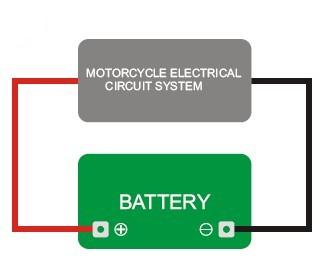
Step1: Connect the battery terminal with the motorcycle’s wire, Red wire connect positive, Black wire connect negative, then start the motorcycle
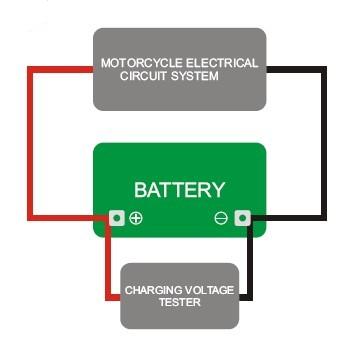
Step2: Connect the charging voltage tester with the motorcycle’s wire. Red wire connect positive, Black wire connect negative, the tester indicate the battery open circuit voltage
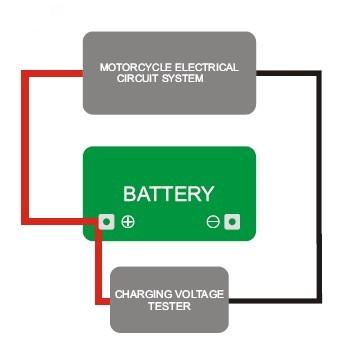
Step3: Disconnect battery terminal with motorcycle negative wire, then the tester will indicate the motorcycle output charging voltage, please control the motorcycle rotate speed at 2000 rotate and 5000 rotate, and check the charging voltage, the charging voltage is ok if charging voltage between 14.0-15.0V, and the battery can work normally. The battery cannot be full charged if the charging voltage less than 14.0V, or the battery would be overcharged if the charging voltage above 15.0V. These two status will damage the battery accordingly, the motorcycle charging system shall be repaired before battery installation
Step4: Stall the motorcycle and take off the key, Connect the multimeter (milliamperes mode function ) with battery negative terminal and motorcycle negative output wire in series, Then check the motorcycle power consumption by Milliamperes model. To make sure the current deliver less than 1mA during motorcycle stall
Step5: if the motorcycle passes the above test, the Skyrich engine starts lithium battery can be installed on the motorcycle
3. Choose correct corresponding engine start lithium ion batteries accordingly to motorcycle model or lead acid model.
4. Check the battery voltage before installation, please recharge the battery first if battery voltage less than 12.4V( follow the charging instruction)
5. Take out the lead acid battery according to motorcycle guide, please make sure disconnect the negative screw and wire, then positive. which avoid the short circuit.
6. Compared with original battery and lithium ion battery
First, check the battery polarity, two kind battery must be same, please contact me if different.
Then check two kind battery dimension, length, width and height, please contact us if the lithium ion battery be too big to install.
Normally. Our lithium ion battery will be same as original battery or smaller, you can install the battery directly if same dimension. If smaller dimension, we adopt following two method to adjust the battery dimension.
Method 1: When the lithium ion battery be lower than original battery, we will equip batteries together with spacer in the box, you can install one or several spacers at the bottom of battery to fit the height of battery.(see picture)
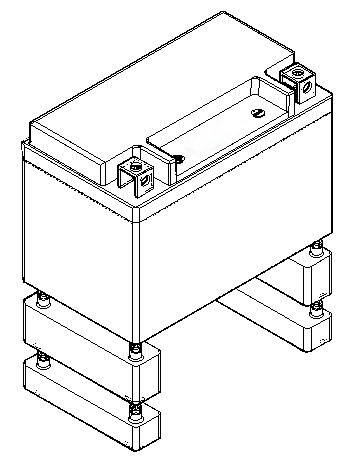
Method 2: we equip some stick foam sheet in the box, you can stick on the sides or bottom to fit original battery size(see picture)
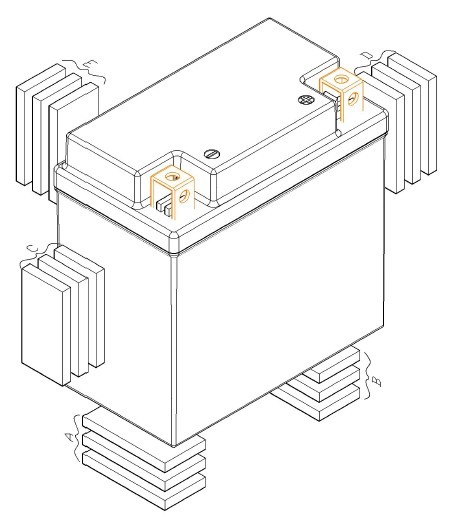
7. Please make sure motorcycle positive and negative wire connect the battery terminal correctly and hardly, Positive first, then negative, which avoids the short circuit.
Ⅱ: CHARGING
1. Both vehicle and battery charger need to limit voltage between 14.0-15.0 volts when charging. The battery cannot be full charged if charging voltage less than 14.0 Volts, and the battery would be damaged if the charging voltage over 15.0 Volts.
2. Always remove the battery from the vehicle before charging separately.
3. Charge the battery with a lower current than the MAX Charging Current found on the Charging label.
4. After charging, leave the battery for 1 to 2 hours before checking the voltage. If the voltage is less than 12.4 volts, additional charging is necessary.
5. If the battery becomes hot to the touch, stop charging. Allow battery to cool before resuming.
Ⅲ: Storage
1. The battery should be stored with 70% charge state (approx).
2. The battery should be stored in a clean, dry and ventilated environment (-20-40Cels), not in contact with any corrosive substance and away from heat and fire.
3. The battery should be charged completely once every 180 days when in storage.
Ⅳ: Transportation
1. The battery should be transported with 70% charge state (approx).
2. The battery should be packed with insulation and shockproof material to avoid damage from sudden jolts and collision.
3. The battery should be handled with care when loading and unloading during transport. Do not throw the batteries and avoid collision.
4. Do not transport the batteries together with flammable, explosive objects, or sharp metal goods.
Ⅴ: Maintenance
1. Disconnect the battery cable always is the best choice if the vehicle is in storage or used infrequently. Or use a standard maintainer or charger to maintain the battery. Or regular charging the battery.
2. If the battery stands by for any period of time, check the voltage in case lower 12.4 Volts, recharge as described on the charging label.
3. Keep the connecting poles clean and securely fastened.
4. The battery is factory sealed and requires no topping up of any fluid. Never attempt to open the battery.
Ⅵ: Cautions
1. Do not immerse the battery in water.
2. Do not use or store the battery near sources of fire or heater.
3. Do not reverse the positive (+) or negative (-) terminals.
4. Do not connect the battery directly to wall outlets.
5. Do not put the battery into a fire or apply direct heat to it.
6. Do not short-circuit the battery by connecting wires or other metal objects to the positive (+) and negative (-) terminals.
7. Do not pierce the battery casing with a nail or other sharp objects, break it open with a hammer, or step on it.
8. Do not strike, throw, or subject the battery to sever physical shock.
9. Do not directly solder the battery terminals.
10. Do not attempt to disassemble or modify the battery in any way.
11. Do not place the battery in a microwave oven or pressurized container.
12. Do not use the battery in combination with primary batteries (such as dry cell batteries) or batteries of different capacity, type, or brand.
13. Do not use the battery if it gives off an odor, generates heat, becomes discolored or deformed, or appears abnormal in any way. If the battery is in use or being recharged, remove it from the device or charger immediately and discontinue use.
14. Do not fit extra Audio, Anti-theft lock and other electro-device on vehicle by yourself.
15. Do not use more than one battery in parallel or in series.
16. Do not press on indicator button longer than few seconds.
17. Do not dispose the battery before completely discharge.
18. Do not charge the battery by charging voltage over 15.0V.
19. Do not charge the battery by charger with an automatic “desulfation mode” function.
20. Please fix the battery terminal with original screws and nuts securely. Battery and even vehicle may be damaged by the sparks because of the loose connect
21. The cranking performance will be affected when environment temperature lower than -5℃.
22. Keep out of reach of Children and Pets.
Ⅶ:Others:
If the problem caused by wrong operation, Skyrich won’t take responsibility for that, Please fill in the warranty card completely and stick on the battery surface, send the battery back company. Otherwise the Skyrich won’t be attend to or serve.
Warning:
Electrolyte inside the battery is harmful to the skin and eyes. If the battery leaks and electrolyte gets in your eyes, do not rub them, instead, rinse them with clean running water and immediately seek medical attention. If left untreated, electrolyte can cause eye permanent injury.






